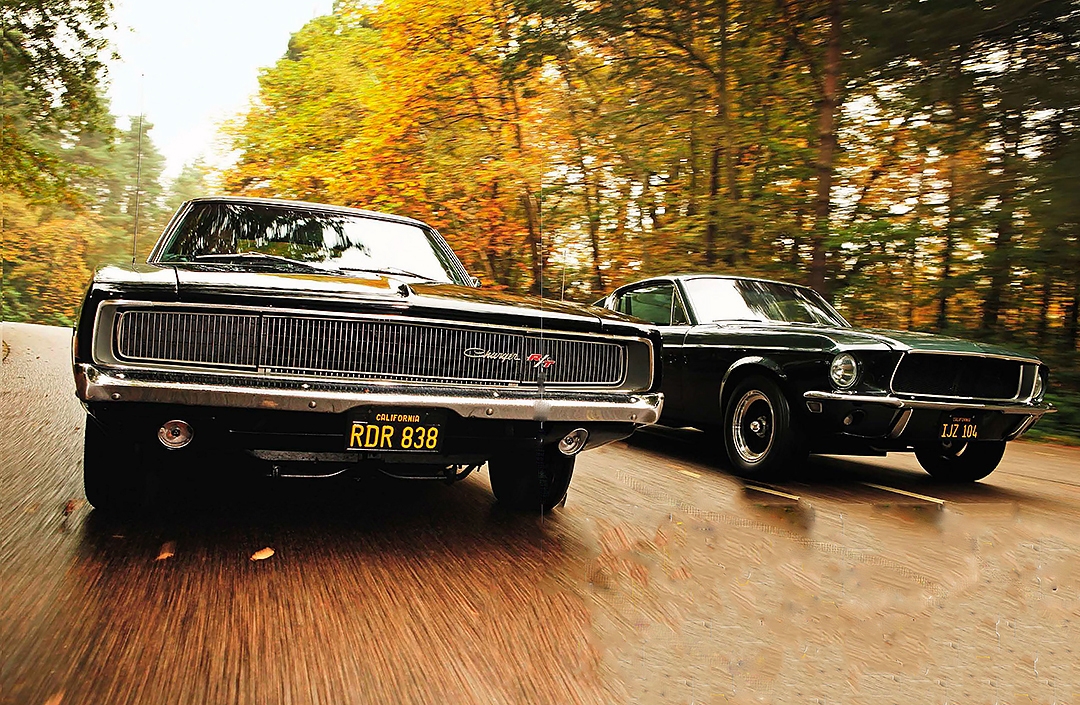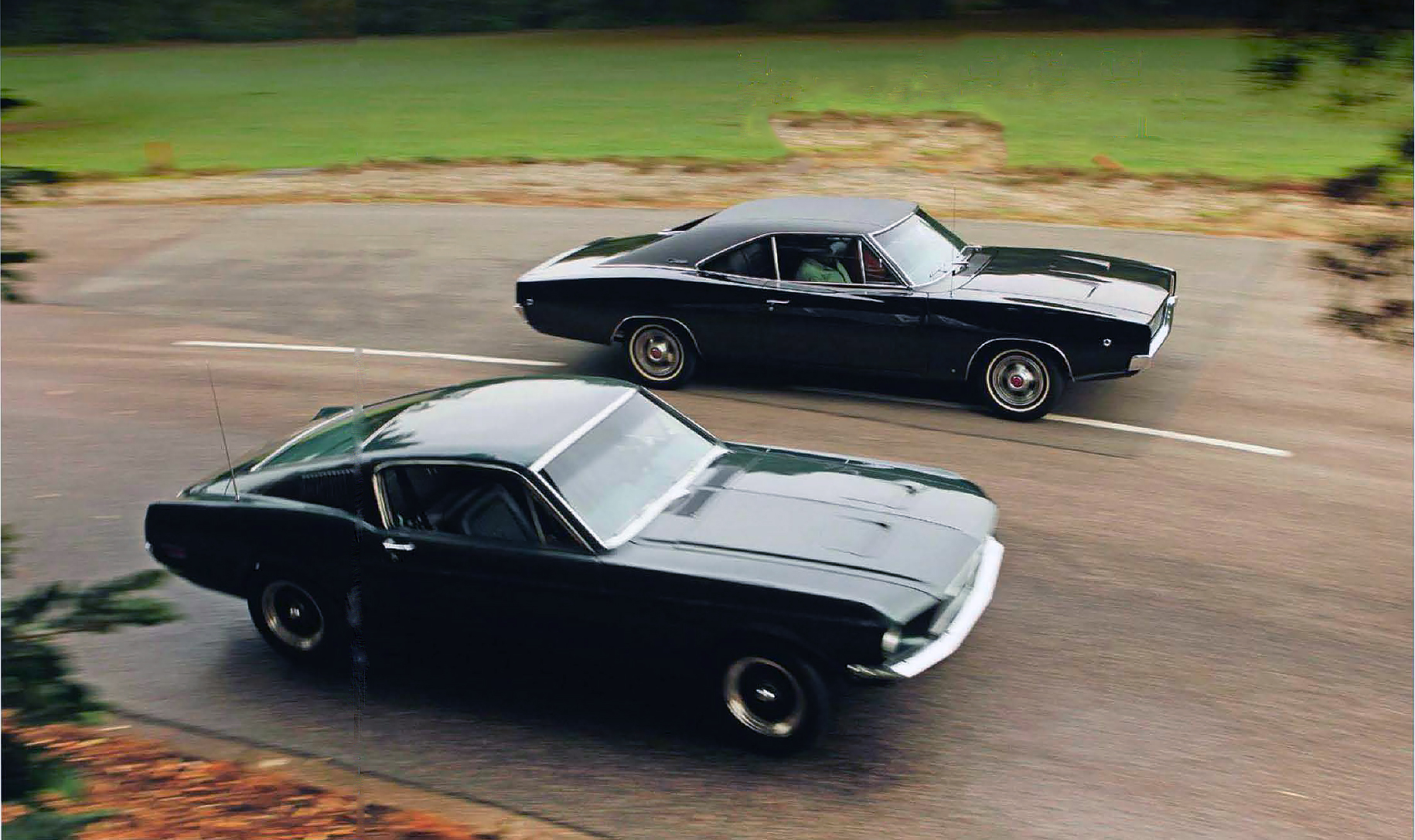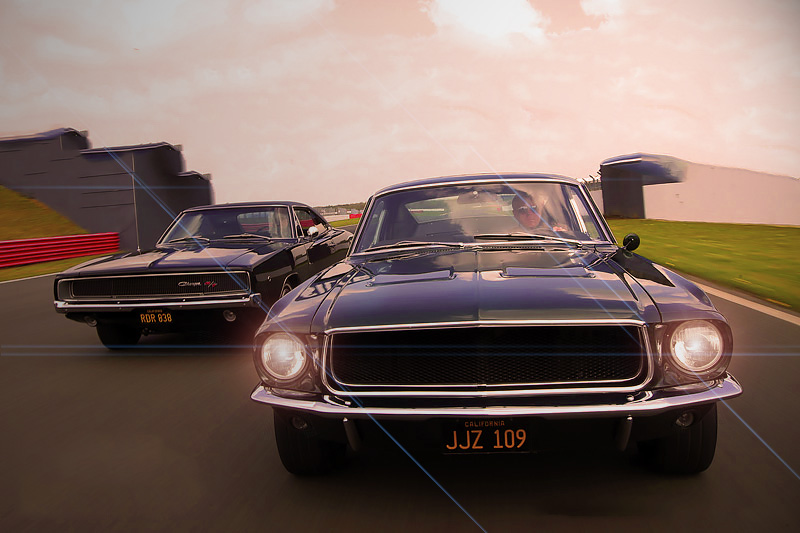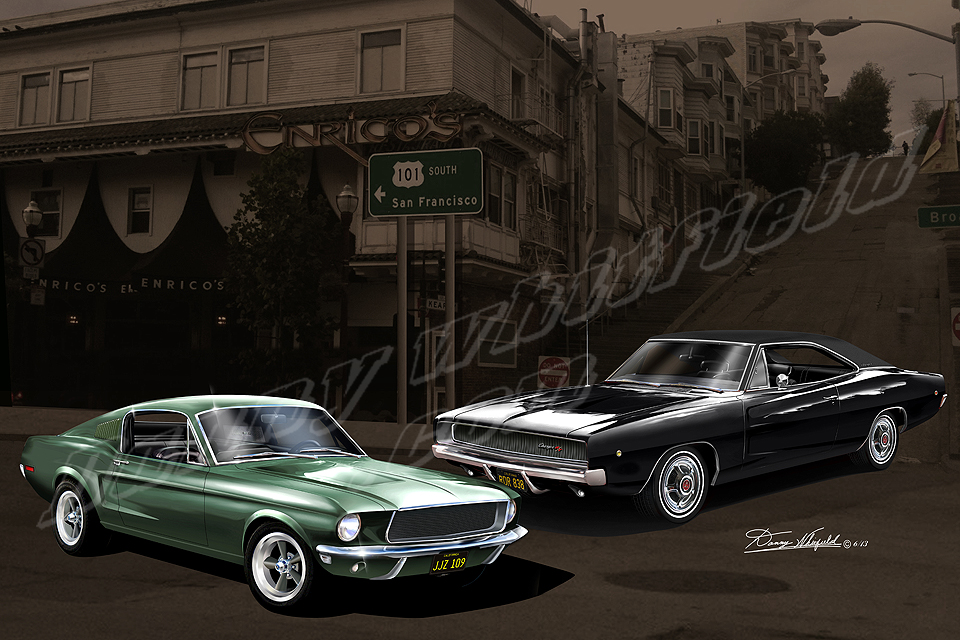
Mick Walsh plays Steve McQueen in exacting replicas of the Ford Mustang and Dodge Charger movie cars to replay one of the greatest celluloid car chases. Photography Tony Baker. You can just imagine Warner Bros dreading Steve McQueen’s presence at pre-production meetings for Bullitt. The sound of his prized Ferrari 275GTB roaring through the gates at the Burbank studios would no doubt have heralded his uncompromising plans for shooting Robert Pike’s novel Mute Witness. His idea of staging a 10-minute car chase around the streets of San Francisco, with a hot Mustang gunning for a mean black Mopar muscle car – and McQueen himself risking all as the stunt driver – must have had producers Philip D’Antoni and Robert E Relyea tearing their hair out.
 Steve McQueen: An audience digs watching something almost all of them would like to do
Steve McQueen: An audience digs watching something almost all of them would like to do
Thankfully, the joint project between the movie giant and McQueen’s Solar Productions allowed the box-office sensation key control over the creative direction. From lead character Lt Frank Bullitt’s suede boots to the debadging of his Highland Green Metallic Ford Mustang 390 GT, the attention to detail is compelling.
The legendary pursuit gripped audiences when it was premiered in October 1968. Story has it that some viewers were sick after the dramatic sequence. McQueen rated Bullitt as his favourite movie, and his passion for speed guaranteed its authenticity. A crew of McQueen’s buddies was enlisted to prepare and drive the cars, including Max Balchowsky, Bud Ekins (who’d doubled for McQueen in the famous Great Escape motorcycle jump), Bill Hickman and Carey Loftin. Even boys from Hunters Point, a school for underprivileged children, were roped in to help control the crowds when the two-week shooting schedule began in May.
McQueen resisted plans to stage the chase on a studio back-lot and insisted on San Francisco. Filming started at 7am, each sequence carefully rehearsed and slowly brought up to speed. Other than a few continuity goofs, such as the number of hubcaps lost by the villains’ Dodge Charger and the visible on-board cameras, it still rates alongside Ronin and The French Connection as one of the greatest-ever car chases. The sharp editing, dramatic angles, spectacular driving and magnificent location combine to make this an iconic and still much-discussed scene. It combined the ideas of McQueen – who demanded absolute realism, with no speeded- up camera tricks – and director Peter Yates, who’d already set a marker for pursuits with Robbery.

The dramatic hilly route and aggressive, NASCAR-style chase required both the Ford and the Dodge to be specially prepared for the relentless programme. The suspension was beefed up with heavy-duty springs and dampers, plus strengthened pick-up points. Refinements such as power steering and air-conditioning were not required. While the Charger looked stock, McQueen had his own ideas for the Mustang. Trim was removed, the grille painted black and mag wheels fitted. McQueen’s fanaticism for detail went down to a special Secura steering wheel, which he had custom upholsterer Tony Nancy trim in black leather.
The star did most of the driving and his mistakes, such as when he overshot a corner and reversed back, were included in the final edit. The Charger was driven by Hickman, disguised under horn-rimmed spectacles, who didn’t say a word throughout, while Ekins deputised for McQueen for the most dangerous runs down Chestnut Street. It was like looking down a ski jump, recalled Ekins. At 60 mph, it felt as if I was driving off the end of the world. The presence of lots of parked cars all around the location greatly added to the authentic feel, although another much-reported mistake is the repeated appearance of a green Volkswagen Beetle.
Rivals on the road
There’s no question that the Dodge stunt driver had the tougher challenge in San Francisco. It looks and feels bigger and, though it has the punch to keep in front on the freeway, in tighter turns it pitches dramatically and tests its skinny tyres – that roll enhancing the drama of the chase. The tail easily steps out on our damp course, but the slide feels reassuringly progressive. Every aspect of its character induces big smiles, from the way it lights the tyres at a sniff of throttle to the meatier soundtrack of the 7.2-litre V8.
The Mustang feels far better planted. Like many Bullitt reps, this car has had its steering modified to rack and pinion; add the extra grip from the wider mag wheels, stronger brakes and stiffer suspension, and the Ford fastback feels as sorted as a Shelby racer. Whereas the Charger fulfils NASCAR fantasies, the Mustang fuels Trans-Am dreams of Laguna and the Glen. I’ve long hankered for a Mustang, but recently my desires have switched to the magnificent Charger. Prowling around at night with friends aboard that menacing Mopar would be a hoot.
Above, clockwise: Mustang interior trim is plush; trick 390cu in V8; Secura wheel with Shelby centre boss. Main: Ford is debadged, as per McQueen’s spec.
The gripping scene has a seamless pace, but the various locations around San Francisco are disjointed and take some hunting down-there’s now a wealth of websites identifying the key sections. McQueen’s acting was never going to worry’ the Oscar contenders, but Frank P Keller did claim the Best Editing gong at the 1969 awards. “I always felt that a motor-racing sequence in the street could be very exciting because you have real objects to work with, like bouncing off a parked car,” said McQueen in a 1969 Motor Trend interview. “An audience digs sitting there watching somebody do something I’m sure almost all of them would like to do.”
Word spread around San Francisco as soon as the cameras started to roll, and crowd control became a major problem during the tight two- week schedule. The sequence when the Charger and Mustang launch over the crossroads down Taylor and Filbert Streets must have caused plenty of headaches for the local police. Balchowsky’s team was kept busy repairing the cars due to the continuous punishment, including a smashed sump, collapsed axle and broken wheel. Every night the vehicles were carefully checked for the next day’s filming. The final flat-out charge was staged on Guadalupe Canyon Parkway, with spectacular views over the bay. For some scenes the Ford and Dodge were hooked together for close-up camera work. Ekins was enlisted for yet another motorcycle stunt as he played the luckless rider who meets the hairy chase and causes the Mustang to spin as Lieutenant Bullitt avoids the falling ’biker.
{gallery}Mustang390GT{/gallery}
The sequence was shot without sound, which was added in the final edit. Again there’s debate about the source of the engine roar, with some claiming that a GT40 was used for the Mustang, McQueen’s double-declutching footwork a clue to its race-car origins. The fate of the Mustangs is often discussed, and some believe that neither survives. The pair had back-to-back serial numbers and, contrary to some reports, both were 320bhp four-speeds. Of the two, one was so badly damaged that it was certainly scrapped immediately after filming had finished. Unlike the Charger, records remain about Ford chassis numbers and the second Mustang, 8R02S12559, was reportedly sold to a Warner Bros employee once editing was signed off in September.
A few years later, the Bullitt 3 90 was advertised for sale in the classifieds of the Los Angeles Times for $6000 and ended up on the East Coast. In 1974 it was back on the market and McQueen spotted the advert in Rond if Track, but the New Jersey vendor informed the star that he was too late. ‘File new keeper’s number was handed over but not even McQueen could talk him into selling, although a promise was made that he’d get first refusal. Steve died of cancer in 1980, having never heard from die reclusive owner. Story has it that the Mustang remained in Newjersey until it eventually moved to a hay bam in the Ohio River Valley. Over the years its condition deteriorated, and those who tracked down the owner to make offers were all turned down. Recent reports place the car in a Tennessee barn, an amazing situation considering that it would be worth several million dollars. One visitor managed to take spy photos of the sad-looking survivor for Bullitt aficionado David Kuntz, but they’ve never been published or posted.
David Redhead was 21 when the movie was released and vividly recalls seeing it in Southend: “I’ve been a Ford man since my first Cortina GT, and I was blown away by the chase. I vowed I’d get a Mustang, but didn’t really believe I would. At the time, I was convinced it was a Shelby. Back then both cars looked big and wild.”
Above: black-painted back panel gives aggressive look to GT-spec car. Right: five- spoke American Racing mag rims. Main: Lt Bullitt’s office, with replica pistol.
Fast-forward to 2005, and Redhead’s dream started to become a reality: “I’d had Fords before, including an Escort 1300E and XR3i, but never a classic. When I started thinking about getting one, the Mustang immediately came to mind. My wife was great. ‘You’ve got to do it, otherwise it will always be one of life’s regrets,’ she said, but with one proviso: ‘I don’t want it to sit on the drive.’” After searching the internet, he eventually sourced a project car for S9000: “It was painted white and the interior had been wrecked by years in the sun, but a friend checked it out for me. I tasked local specialist Scott Andrews to restore it before bringing it here.” The more Redhead researched the original stunt car, the more particular he became about getting the details authentic-from blacking-out the ’67 grille insert to peeling off the stickers on the American Racing Torq-Thrust D rims. When the Mustang was three-quarters done, he shipped it home and sent it to Javed Ahmed, a Scottish-based restorer who took another two years to finish the car. During the drawn-out rebuild, Redhead built up quite a reputation as a Bullitt expert. After completing his own car, he masterminded a second – the Mustang you see here – for a friend. “It was wonderful to finally get behind the wheel,” says Redhead. “We’ve put discs on the front and fitted power steering. It’s gripping to drive and really flies, but you have to get used to the hooting and cheering from other road users. I enjoy using it to raise money for charity and rent it out for parties and weddings.”
{gallery}Bullitt-and-SteveMcQueen{/gallery}
Having watched the film untold times, built a replica, launched a website (motion picturemotors.co.uk) and now planning a book, Redhead’s dream is to take his car to California and retrace the route. That’s unlikely to happen, although he did enjoy a guided tour in a police car with patrolman David Oberhoff: “It was a brilliant day; he showed us all the landmarks before treating us to an authentic diner lunch.”
While Ford was officially involved in Bullitt, the baddies’ Dodge was sourced independently. Yates initially had a problem convincing Warners to used any other marque due to the Ford contract, but McQueen eventually persuaded the management. There are various reports that two cars (some say three) were acquired by stunt supremo Bill Hickman from Glendale Dodge, but one, a blue automatic, was not an R/T, while the main film vehicle was a full-house 440 Magnum finished in light yellow. Both were repainted menacing black, and for safety the suspension was given shortened torsion bars, reinforced lower arms, stiffer dampers and NASCAR springs at the back from Bonneville man Norm Thatcher. Each had a 375bhp, four- barrel 440cu in Magnum V8. Stylist Richard Sias’ long, lean double-diamond ‘Coke bottle’ profile and flying-buttress rear window made the perfect villains’ machine. With its hideaway lights plus black grille and body, it had an evil presence straight off the production line.
It is said that the Charger outgunned the Mustang when the cars were tested on a track prior to filming the action scenes. McQueen supposedly became frustrated by the Dodge’s spectacular performance as they practised 100 mph side-by-side routines for the highway chase. Director Yates was annoyed when the Mustang was presented for filming with dents and stone-chips from the circuit rehearsal, but McQueen argued that the used look better suited the resolute Lieutenant’s character. There are rumours that two plug-leads were pulled off to slow the Charger, while the Magnum 500 wheels were switched to narrow steels to give the cornering more drama. With 375bhp on tap, stunt driver Flickman could easily” torture the rear rubber for smoky exits from the turns.

From top; we don’t want to glamorise guns, but pump- action wielded by white haired man is part of show detailing; stylish lamps; hubcaps fall off in chase.
Like the famous Mustangs, the Chargers’ life stories have long been a mystery. It is generally believed that one, the non-R/T, was written off during the final explosive scene, although anyone familiar with die movie will have spotted that the Dodge appears to overrun the gas station before it blows up. Some claim that all of the cars were scrapped after filming for insurance reasons, but it’s also said that the Dodge dealer bought back the pukka and still low-mileage R/T, and returned it to yellow before selling it on to an unsuspecting punter. Had the second owner lifted mats he’d have found several mysterious holes, which were drilled to fit camera mounts. This car was primarily used for close shots of driver and shotgun-toting passenger.

Recently, news spread across the internet that the Bullitt Charger had survived, after being discovered in Tucson in a sad state in the late ’90s by seasoned Mopar enthusiast Arnold Welch. He became intrigued about the car’s colourful history when layers of paint were revealed during restoration, as he sanded through yellow to black, to original yellow. “The first owner had purchased the car at Valley Dodge in Van Nuys, California in 1970,” says Welch. “It’s only done 62k and hasn’t beendriven since 1973. Myinterest was alerted because it had a matching-number 440 Magnum motor, original Hemi four-speed and Dana 60 rear end.” After extensive research on the VIN and build date (15 January 1968), Welch contacted the Warner Bros archive but unfortunately all records had been lost or destroyed. With nothing to prove the movie connections, the only route was to match the mystery holes in the shell to photos of Bullitt Chargers on location. For one action sequence, the second Dodge doubled as a tracking car with the bootlid removed and the cameraman sitting in the trunk, and mounts for the lighting-pole supports seem to match the drilled holes. Since the rebuild, Welch has shown the Charger at selected events and it’s now up for sale, with a whopping 1 000 000$ price-rag.
Owning a genuine film car was never an option for Chris How, who jumped in at the deep end with his Charger. Redhead and How have known each other since school, and his pal’s infectious passion for the movie had a dramatic influence. “I’d always been a McQueen fan, but The Great Escape was my favourite,” says How. “It was all kick-started in 2006 when David told me he was going to LA to look at a Mustang. The trip tempted me, and that’s when I realised how fanatical he was. Back home I got more involved, and when an investment bombed I decided I’d rather put my money into something more rewarding. I’d never owned a classic and the Dodge seemed the obvious choice.”
Even though How had never even sat in a Charger, he immediately made a plan: “The car looks awesome. It’s so mean and, unlike bland modems, has lots of character. I started researching the history and options. We looked at loads for sale and narrowed it down to three: one in New York, another in Texas and one in Burbank. Just as I’d decided on the California car, it was taken off eBay. Luckily it came back after time- wasters and Bruce Reckard checked it out.” After a thumbs-up, How wired the money and arranged shipping: “It came in a container via Chatham, but wasn’t unloaded until its arrival in Derby. I ended up Inlying a low-loader to pick it up. From 200 yards it looked fantastic, but on closer inspection it was soaked through. Once we’d got it started and I heard the exhaust bubbling away, however, I was happy.”
From top: Charger has the legs, but Mustang corners better: movie still shows how dose the drivers were: Yates briefs star McQueen.
How instructed Custom Exotics in Harlow to start transforming the car into a Bullitt clone. “The body was covered in microblisters, so we decided to investigate and, after buzzing off some paint, we were horrified to find surface rust underneath,” says CE’s Scott Brocklehurst. “It had clearly been sitting outside for a couple of years before a blow-over to sell. We took it back to bare metal and had it blasted with crushed garnet stone to avoid panel distortion. But, other than evidence of a side impact, it was a good, straight car. Muscle cars are our speciality and it was great to finally do a Charger R/T.”
{CONTENTPOLL [“id”: 9]}
While the metallic-green car was away being resprayed black, How’ started sourcing parts to match the movie car: “It already had a black interior and the correct engine. I found some 14in steels to replace the Magnums it came with, and ended up buying 11 hubcaps to get a perfect set. The vinyl-roof kit came from California, and the overriders were taken off as they did for filming to mount die cameras.”
So, did the finished Charger live up to expectations when How finally got behind the wheel? “I love driving it,” he enthuses, “and get a buzz from the attention it gets wherever we take it. You have to respect the power because it’s really quick. The brakes aren’t brilliant and it under-steers terribly, but the automatic ’box is fantastic. You can’t feel the changes and it’s as good as my modem Mercedes. My respect for Bill Hickman, who drove the stunt car, really rocketed. I never tire of the styling, and driving in convoy with David’s Mustang is fantastic fun. My first cruise along the Southend seafront was special.
Thanks to Mike Siegel and Andrew Antoniades, whose definitive book Steve McQueen: The Actor and his Films costs £39, published by Dolton Watson. See daltonwotson.com.
Clockwise, from right: Dodge Charger 440R/T – 440 Magnum V8 has 375bhp; cabin is resolutely black; 17ft Charger is roomy in the rear; smooth auto.
“And… cut!”
British director Peter Yates wasn’t overjoyed about moving to California to direct Bullitt, but once he had got stuck into the project his relationship with the film’s problematic lead McQueen went well. To this day. there’s debate about the origins of the car chase, with Yates claiming that it wasn’t in the original script by Alan Trustman (who also wrote The Thomas Crown Affair), while McQueen always insisted in interviews that it was his idea.
“I accompanied him in the Mustang on one of the hill-jumping sequences to keep an eye on him.” recalled Yates. “After one of the jumps, I had to tell him to slow down because we were out of film. ‘That’s nothing,’ Steve replied. ‘We’re out of brakes’ McQueen managed to slow the Mustang by slotting down through the gears and turning the car onto a street that inclined upwards. When the car came to a stop, we roared with nervous laughter!’
| Car |
Dodge Charger 440r/t |
Ford Mustang 390 GT |
| Made as | USA | USA |
|
Sold |
1968-1970 | 1968 |
| Number built | 470 | 200 |
| Construction |
steel monocoque |
all-steel monocoque |
| Engine | all-iron, OHV Chrysler RB-series 7206cc V8, Carter AFB 4-barrel carb |
all-iron, overbead-valve 6400cc (390cu in) V8, Holley carburettor |
| Max power | 375bhp @ 4600rpm |
320bhp @ 4800rpm |
| Max torque | 480lb ft @ 3200rpm | 428lb ft @ 3200rpm |
| Transmission | four-speed manual or three-speed TorqueFlite auto, RWD | four-speed manual, RWD |
| Suspension |
front independent, by unequal-length wishbones, coil springs, telescopic dampers rear live axle, semi-elliptic leaf springs, telescopic dampers |
front independent, by unequal-fength wishbones, coil springs, telescopic dampers, anti-roll bar, export brace rear live axle, semi-elliptic leaf springs, telescopic dampers |
| Steering |
recirculating ball |
recirculating ball |
| Brakes |
All Drums |
discs front, drums rear |
| Measurements |
17ft 4in (5283mm) Width 6ft 4 1/2in (1946mm) Height 4ft 5in (1346mm) Wheelbase 9ft 9in (2972mm) |
Length 15ft 4in (4674mm) Width 5ft 11 in (1803mm) Height 4ft 4in (1321mm) Wheelbase 9ft (2743mm) |
| Weight | 3737lb (1695kg) |
3340lb (1515kg) |
| 0-60mph |
6.4 secs (four-speed manual) |
6.2 secs |
| Top speed |
114mph (four-speed manual) |
130mph |
| Mpg |
8 (four-speed manual) |
12 |
| Price new |
$3506 (USA 1969) |
$3700 (USA 1969) |
| Price now |
£60,000 |
£40,000+ |





